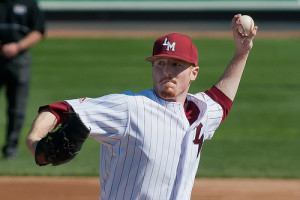
A wearable sensor that tracks strain on a pitcher’s elbow is making waves in major league baseball (MLB). The mThrow, by Motus Global, is a simple, lightweight sleeve, designed to be worn every time a pitcher throws. The smart throwing sleeve and companion iOS app collects and analyzes real-time biomechanical data from each game and practice, and uses that data to calculate workloads and recommend daily throw limits. This season, 27 MLB teams and their minor league affiliates are trying out the device, in the hope that it will help monitor pitchers’ workloads, improve pitching mechanics, and prevent injuries.
Pitcher UCL Injuries Increasing
The timing of the introduction of the mThrow app is fortuitous. “During the past few years there has been an “epidemic” rise in the number of professional pitchers requiring ulnar collateral ligament reconstruction,” according to the American Sports Medicine Institute. Also known as “Tommy John” surgery, named after major league pitcher Tommy John, the first baseball player to undergo the surgery, the reconstruction replaces a ligament in the medial elbow with a tendon from the forearm, hamstring or foot. Recovery from a Tommy John surgery can take up to 12 months and requires intense rehabilitation.
The mThrow could help curb this trend. Baseball managers have attempted to control UCL tears by imposing limits on the numbers of throws or innings pitched, without much success. According to Thomas Karakolis, of the University of Waterloo in Ontario, Canada. “Baseball managers should be figuring out the forces on muscles, tendons, and ligaments for each player and guiding them based on that,” he states. The mThrow might be a step in the right direction, by helping to judge the level of stress on a pitcher’s elbow joint and indicating when the pitcher’s arm may be getting fatigued.
“Up until now the only way to control this injury and figure out how much work a guy is doing is through the pitch count. But pitch counts are not created equal for everyone. These things (mThrow sensors) are actually able to measure the force on the UCL—the rotational forces are the only thing that’s directly linked to UCL injuries,” says Lindsay Berra, columnist for MLB.com, in a review of the mThrow product. Berra believes Motus’ new pitching sleeve could revolutionize how baseball analyzes pitcher fatigue and workload to prevent injuries.
mThrow For Youth Pitchers?
Almost 49% of youth baseball pitchers will suffer an elbow or shoulder injury in 2015, says to Steven Ellis, former Chicago Cubs pitching pro. Today’s kids play competitive sports year round and specialize at earlier and earlier ages. Repetitive injuries can be especially hard for children who are vulnerable because they are still growing. Safe Kids Worldwide, a global organization dedicated to preventing injuries in children, states that more than 3.5 million children ages fourteen and younger get medical treatment for sports injuries each year.
Use of the mThrow app for student-athletes could provide coaches and parents with real-time data and realistic workloads. And because the mThrow sleeve tracks the workload on a child’s UCL, the ligament responsible for elbow stability, the data collected on arm slot angle, shoulder and forearm rotation, throw count, and arm speed could help coaches and parents accurately assess stress and fatigue levels, and avoid repetitive UCL injuries. The device’s maker, Motus Global, in Massapequa, NY, has launched a consumer version of the app, which is available in its online store.
What do you think? If you’re a coach, especially a high school baseball coach, do you see devices like this adding value for your players?
photo credit: John Lally via photopin (license)

